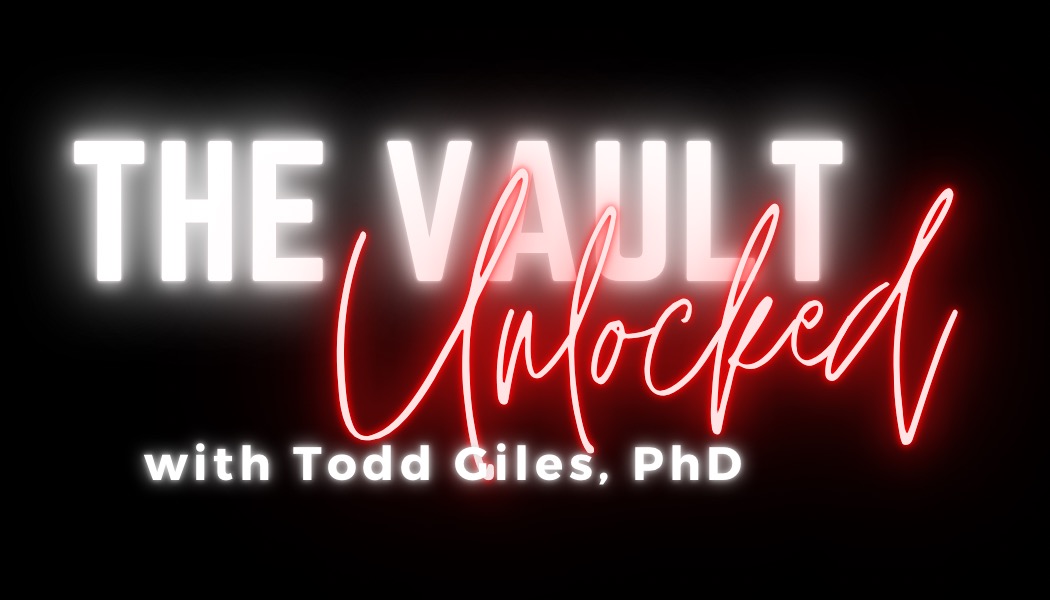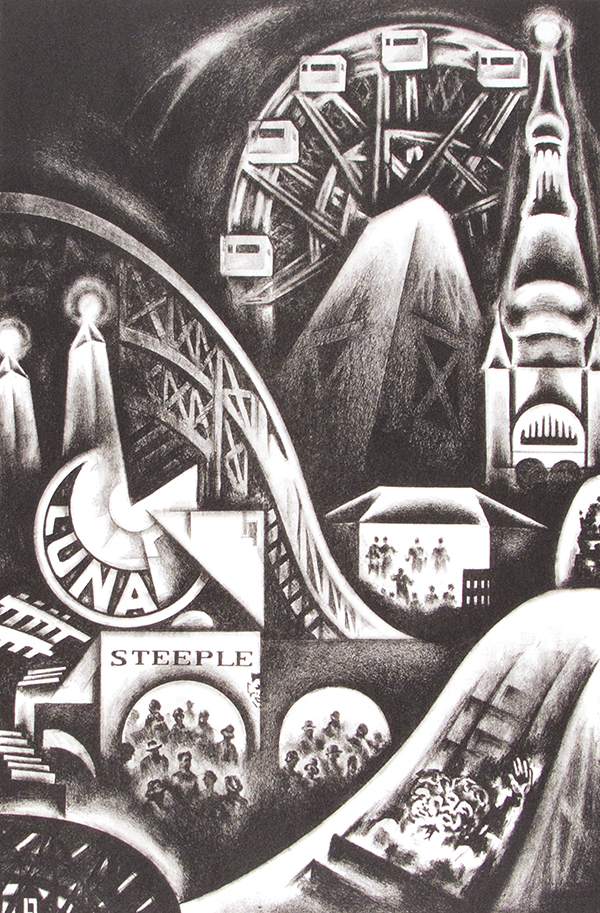
Ever wonder where the art is stored at the WFMA, and what's in there anyway? Join MSU professor Todd Giles as he unlocks the vault!

Louis Lozowick
Luna Park, 1926
Lithograph
13 1/2 x 9 in.
Signed and dated in pencil, lower right corner
One of twenty
Printed by George C. Miller
Museum purchase, 1978
Louis Lozowick (1892-1973) was born in Kiev; he moved with his family to the US in 1906 at the age of fourteen. Having begun his art studies for two years prior to emigrating, he picked them back up at the New York National Academy of Design, where he studied from 1912-1915. He then earned his BA at Ohio State University in 1918.
Known as an American Precisionist painter like Georgia O’Keeffe and Charles Sheeler, Lozowick’s early influences stem from the Italian Futurists’ painterly embrace of the dynamism of the new machine age, as well as the Russian Constructivists, who likewise lauded modern science and industry. He is best known for his lithographs of cities, industrial projects, and workers that he produced in the late 1920s and early 1930s.
Lozowick traveled widely throughout the US prior to leaving for Paris in 1919, visiting places like Detroit, Cleveland, Chicago, Pittsburgh, and the state of Oklahoma. From these journeys came a series of oil paintings making up his Cities series, which were painted between 1924–1927. Much like Charles Sheeler’s depictions of Ford Motor Co.’s River Rouge Plant in 1927 (see Sheeler’s Industrial Series #1 in the WFMA’s permanent collection), Lozowick based his paintings in the Cities series on earlier sketches and lithographs made during his travels.
Like many American Modernists in the museum’s collection, Lozowick traveled widely throughout Europe; he even visited Russia, where he was inspired by the machine aesthetics and geometric abstractions mentioned above. He returned to the US in 1924. Two years later, he became an illustrator for the New Masses, at which time his style switched from the hard lines and formality of Precisionism to the more naturalistic approach we see in his Luna Park of the same year, 1926. In short, Precisionism tended to exclude the human element, whereas in Luna Park, we are still presented with his geometric style, but also get treated to the spirit of the place with the inclusion of the crowd enjoying themselves at the amusement park.
In the early twentieth century, artists of all stripes were compelled to depict New York City’s crowded environments—from Social Realists represented in the WFMA’s collection such as John Sloan, Mabel Dwight, and Reginald Marsh, to Modernists like John Marin, Stuart Davis and Armin Landeck. Lozowick was no different.
In Luna Park, he shows his Futurist side by depicting the energy, movement and excitement of Coney Island’s famous Luna Park, which entertained millions of Americans and foreign visitors from 1903 until it burned down in 1944. Luna Park was designed with minarets, spires, domes and over 250,000 electric lights.
In 1927, the year following the lithograph under discussion, Lozowick wrote the following in an essay titled “The Americanization of Art”:
The dominant trend in America of today, beneath all the apparent chaos and confusion, is towards order and organization which find their outward sign and symbol in the rigid geometry of the American city: in the verticals of its smoke stacks, in the parallels of its car tracks, and the squares of its streets, the cubes of its factories, and arches of its bridges, the cylinders of its gas tanks.
In Luna Park, we certainly see the “rigid geometry,” “verticals,” “parallels,” “squares,” and “arches,” but we also get those two thrill-seeking faces in the lower right as they whiz by on the rollercoaster. Likewise, we also see the Cubist influence in the simplification and angularity of overlapping forms. Luna Park is really a hodgepodge of styles brought together by Lozowick to create his own unique aesthetic that invites the eye to follow its energetic flow. Follow, for example, the stiff vertical line of the Electric Tower from its base to the top on the upper right side; then flow over the top of the Ferris wheels, down the steep rightward curves of the roller coaster tracks, which temporarily disappear behind a building before rising again right under the base of the tower, before they come rushing headlong towards us in the lower right corner.
Notice too, the repetition of shapes: circles, squares, triangles, parallel lines. Just below one of the parks famous half-moon Luna signs which adorned the park’s entrance, we see the word “Steeple” on one of the buildings; this is a reference to one of the two other parks on Coney Island at the time, Steeplechase and Dreamland. Also, in the lower left of the print, we see the artist’s monogram—two capital Ls, the one on the right turned on its head 180 degrees. Louis Lozowick.
Works Consulted
Adams, Clinton. American Lithographers, 1920s-1960s: The Artists and their Printers. U of New Mexico P, 1983.
Davidson, Abraham A. Early American Modern Painting, 1910-1935. Harper & Row, 1981.
Fern, Alan and Ellen S. Jacobowitz, et al. American Graphics: Selected from the Collection of the Philadelphia Museum of Art. Philadelphia Museum of Art, 1982.
Schrader, Stephanie et al. True Grit: American Prints from 1900-1950. J. Paul Getty Museum, Los Angeles, 2019.
Luna Park from the Permanent Collection of the Wichita Falls Museum of Art at MSU Texas
View Previous The Vault Unlocked
-
Tuesday - Friday
10:00AM - 5:00PMSaturday
1:00PM - 5:00PM